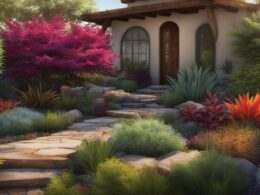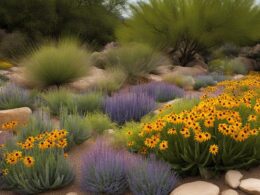If you’re a homeowner looking to create a beautiful and low-maintenance landscape while conserving water, xeriscape design is the solution for you. By incorporating drought-tolerant plants, efficient irrigation systems, and sustainable landscaping techniques, you can transform your yard into a stunning oasis that thrives even in dry climates.
With xeriscape design, you can say goodbye to the constant watering, mowing, and maintenance typically associated with traditional landscaping. Instead, you’ll enjoy a landscape that is not only visually appealing but also environmentally friendly and resource-conscious. Let’s explore some xeriscape design ideas that will help you create the perfect outdoor space:
Key Takeaways:
- Choose native plants that are well-adapted to your climate and require less water.
- Incorporate mulch to reduce evaporation, improve soil fertility, and inhibit weed growth.
- Consider low-maintenance groundcovers and grasses that thrive with minimal water and trimming.
- Add hardscape elements like eco-friendly walkways and rock gardens to enhance the aesthetics and functionality of your xeriscape design.
- Xeriscape design offers homeowners the benefits of water conservation, lower maintenance requirements, and a visually appealing landscape.
The Importance of Mulch in Xeriscape Design
Xeriscape design relies on smart choices to create a beautiful and sustainable landscape. One of the key elements in this design approach is the use of mulch. Mulch offers numerous benefits for xeriscape gardens, from conserving water to enhancing the overall aesthetics of the space.
Organic mulch, such as pine bark and shredded bark, is an excellent choice for xeriscaping. It not only helps retain soil moisture, reducing the need for watering, but also improves soil fertility and structure. Additionally, organic mulch acts as a natural weed suppressor, minimizing the time and effort required for maintenance.
“Mulch plays a crucial role in xeriscape design by reducing evaporation, improving soil fertility and structure, limiting weed growth, and enhancing the overall aesthetics of the landscape.”
Inorganic mulch, such as crushed stones and gravel, is another option that complements xeriscape designs with rock gardens or succulents. In addition to conserving water, inorganic mulch offers a low-maintenance solution without the need for replacement or decomposition.
The Benefits of Mulch in Xeriscape Design
- Water Conservation: Mulch helps retain moisture in the soil, reducing the need for frequent watering.
- Weed Control: Mulch acts as a natural weed suppressor, minimizing the growth of unwanted plants.
- Soil Improvement: Organic mulch enhances soil fertility and structure, promoting healthy plant growth.
- Aesthetics: Mulch enhances the overall appearance of the xeriscape garden, creating a neat and cohesive look.
When choosing mulch for xeriscape design, it is crucial to select natural and clean options to avoid harming the soil and wildlife. By incorporating the right mulch into your xeriscape design, you can maximize water conservation, reduce maintenance efforts, and create a visually appealing outdoor space.
Xeriscape Groundcovers: Creating Beautiful and Low-Maintenance Landscapes
When it comes to designing a xeriscape yard, choosing the right groundcovers is essential. These low-maintenance plants not only add beauty and texture to your landscape but also help conserve water and reduce the need for extensive maintenance. By selecting drought-tolerant grasses and ornamental grasses, such as creeping thyme and lantana, you can create an attractive and environmentally sustainable outdoor space.
Drought-Tolerant Grasses
Drought-tolerant grasses are an excellent choice for xeriscape yards as they can withstand dry conditions and require minimal watering. Ornamental grasses like zoysiagrass and low-lying sedum are tough and resilient, making them perfect for areas with limited water availability. These grasses spread quickly, providing excellent ground coverage and reducing the need for additional maintenance.
Creeping Thyme and Lantana
Creeping thyme and lantana are popular groundcovers for xeriscape yards due to their low-maintenance nature and ability to thrive in arid environments. Creeping thyme is a low-growing plant that forms a dense mat of fragrant foliage and colorful flowers. With its vibrant blooms and attractive foliage, lantana adds a splash of color to your landscape while requiring minimal care. Both of these groundcovers suppress weed growth, conserve moisture, and contribute to the overall beauty of your xeriscape design.
By incorporating these low-maintenance groundcovers into your xeriscape yard, you can enjoy a beautiful and sustainable landscape that saves on water usage and reduces the need for constant upkeep. Whether you choose drought-tolerant grasses or ornamental grasses like creeping thyme and lantana, these plants will enhance the visual appeal of your yard while promoting water conservation and environmental sustainability.
Hardscape Ideas for Xeriscape Gardens
When it comes to designing a xeriscape garden, incorporating hardscape elements can greatly enhance both the functionality and aesthetics of the space. By incorporating eco-friendly walkways, gravel paths, rock gardens, and rain gardens, you can create a visually stunning landscape that is also sustainable and water-wise.
1. Eco-friendly Walkways
Eco-friendly walkways are a great addition to any xeriscape garden. Consider using permeable pavers or gravel to create a walkway that not only provides functionality but also allows rainwater to penetrate the soil. This helps to reduce erosion and allows water to reach the roots of your plants, promoting their overall health and growth.
2. Gravel Paths
Gravel paths are another excellent hardscape idea for xeriscape gardens. They add a natural and rustic touch to the landscape and are easy to maintain. The porous nature of gravel allows rainwater to permeate the soil, reducing the need for additional irrigation. Plus, gravel paths are a cost-effective option that adds texture and visual interest to your garden.
3. Rock Gardens
Rock gardens are a popular choice for xeriscape gardens as they not only add beauty but also help to conserve water. Incorporate boulders and rocks of different sizes to create interesting focal points in your garden. Paired with drought-tolerant plants, rock gardens can create a stunning display, mimicking the natural beauty of arid landscapes while requiring minimal water.
4. Rain Gardens
Rain gardens are designed to collect and store stormwater, making them an excellent addition to any xeriscape garden. By choosing plants that can tolerate both dry and wet conditions, rain gardens help to reduce runoff and conserve water resources. These gardens are typically designed in low spots to allow for proper drainage and can be a visually striking and environmentally conscious addition to your xeriscape design.
By incorporating these hardscape ideas into your xeriscape garden, you can create a beautiful and sustainable outdoor space. Eco-friendly walkways, gravel paths, rock gardens, and rain gardens not only add functionality but also enhance the overall aesthetics of your landscape. Embrace the principles of xeriscape design and enjoy a water-wise garden that is both visually appealing and environmentally friendly.
How Can I Implement Eco-Friendly Xeriscape Practices in My Home’s Design?
Implementing eco-friendly xeriscape practices in your home’s design can be a great way to conserve water and minimize maintenance. Consider using native plants, drought-resistant landscaping, and efficient irrigation systems to reduce water usage and create a sustainable outdoor environment. Ecofriendly xeriscape practices can help you save money and reduce your environmental footprint.
Conclusion
Xeriscape design offers homeowners numerous benefits, making it an excellent choice for water-wise landscaping. By utilizing native plants, homeowners can create a beautiful and sustainable outdoor space that requires minimal maintenance. With a thoughtful xeriscape design, you can enjoy a visually appealing landscape while conserving water and contributing to environmental sustainability.
One of the key advantages of xeriscape is its low-maintenance nature. By incorporating native plants that are adapted to the local climate and soil conditions, you can reduce the need for excessive watering, fertilizing, and pruning. This not only saves you time and effort but also reduces water consumption and the use of chemicals in your yard.
Another benefit of xeriscape design is its ability to conserve water resources. Native plants have evolved to thrive in their specific regions, often requiring less water than non-native species. By choosing these water-wise plants and implementing efficient irrigation systems, you can significantly reduce your water usage while still enjoying a vibrant and lush landscape.
Furthermore, xeriscape design promotes environmental sustainability. By utilizing native plants, you support local ecosystems, providing habitats for beneficial insects and wildlife. Additionally, the careful selection of hardscape elements, such as permeable pavers and gravel paths, allows rainwater to be absorbed into the soil, replenishing groundwater reserves and minimizing runoff.












